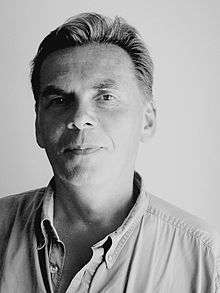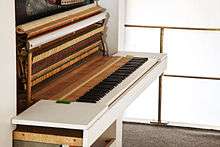David Klavins

David Klavins (born July 5, 1954 in Bonn) is a German-Latvian piano maker. With his "Modell 370" (1987) he introduced the world's largest piano. In 2012, a digital version of the Modell 370 was published as a software instrument under the name "The Giant".
Life
In 1945, David Klavins's parents, Paulis and Zeltite, arrived as refugees from Latvia in Germany. David is the third of eight children. His mother played the piano and his father was a violinist. After finishing middle school in 1971, David Klavins started an apprenticeship as a piano maker at the Wilhelm Schimmel Pianofortefabrik in Braunschweig. In 1976, he started his own business, the "Klavierhaus Klavins" in Bonn. He mainly restored and sold used home and grand pianos. In 1980, he became a master craftsman, which, in Germany, meant that he could officially train apprentices.
Modell 370


While restoring and studying the architecture of grand pianos, Klavins became a critic of the traditional way to construct these instruments.[1] He stated that the materials used in common piano making are outdated and don't reflect the current status of materials science. With this in mind, Klavins designed a piano with a size, shape and interior construction based on modern knowledge of acoustics – rather than the historical construction guidelines used in traditional piano making. In November 1987, he presented the "Klavins Klavier Modell 370" to the public in the German city of Bonn. It had its name from its height: 370 centimetres. In contrast to horizontally built grand pianos, the Modell 370 is laid out vertically. It weighs two tons and stretches over two floors. The piano player sits on the bench in the top floor, while the main part of the strings and the resonance body continue below his feet. Due to this construction, the sounding board, responsible for the acoustic breadth of the instrument, is of double size of an ordinary concert grand piano. This leads to a rich sound and a larger spectrum of overtones. The lowest bass string is 3.03 meters long – about three times longer than in a standard piano.[2][3] As of 2012, the Modell 370 is the largest piano worldwide.
The instrument was first played to the public by the classical pianist Cyprien Katsaris. Today it is stored in the Pfleghofsaal of the Institute Of Music Science, Eberhard Karls University, Tübingen. Klavins never intended to produce the instrument in series. Many pianists asked Klavins for a (horizontally built) grand piano with his construction technique. This led to the "Modell 408", which was scheduled to enter production in the summer of 2014. In May 2012, the Berlin music software developer Native Instruments introduced the Modell 370 as a software instrument, sampled by Uli Baronowsky, under the name "The Giant".[4]
Una Corda
On June 7, 2014, working closely with Nils Frahm, the Una Corda piano was released. The construction was inspired by building a portable upright piano similar to Model 370, which features an open design with no cabinet, and 64 individually stringed keys, altogether weighing at 100 kg.[5] This further lead to a live showcase on June 10, 2014 with Nils Frahm in Michelberger Hotel, Berlin.[6] On December 12, 2015, Uli Baronowsky and Galaxy Instruments collaborated with Native Instruments releasing a fully realized virtual instrument that closely captures the original Una Corda.[7]
Music Label
In order to publish music played on the Modell 370, David Klavins, in 1988, founded his own record label, "Klavins Music", which was later bought by "Elite Music" in Taiwan and BMG-Asia. Among the concert pianist performing on that label were Michael Ponti, Thomas Duis, Joachim Arnold, Gülsin Onay, Michael Denhoff, Simon Nabatov and Wadik Polyonow.
Years of travel
In 1988, David Klavins moved to the country of his parents, Latvia, and worked in politics. In order to pursue his piano research, in 2006 he moved to Woodbridge, Connecticut. In 2011 he returned to Germany and now lives in Balingen, near Stuttgart.
References
- ↑ The Organ, Musical Opinion, 1990, p. 199-202
- ↑ Edwin M. Good: Giraffes, Black Dragons, and Other Pianos: A Technological History from Cristofori to the Modern Concert Grand. Stanford University Press 2002, p. 306. ISBN 978-0804733168
- ↑ James Parakilas: Piano Roles: A New History of the Piano. Yale University Press, 2002, p. 57. ISBN 978-0300093063
- ↑ http://www.native-instruments.com/en/products/komplete/keys/the-giant/
- ↑ http://klavins-pianos.com/b/unacorda_en.htm
- ↑ https://www.youtube.com/watch?v=R49faHgWW9w
- ↑ http://www.native-instruments.com/en/products/komplete/keys/una-corda/
External links
- Klavins piano house in Bonn
- David Klavins Homepage with details about his piano construction and critique